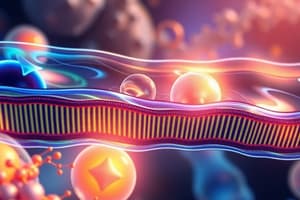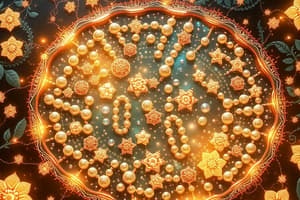Podcast
Questions and Answers
What is primarily illustrated in the presentation regarding cell membranes?
What is primarily illustrated in the presentation regarding cell membranes?
- Structural components of the cell membrane (correct)
- The differentiation of various types of cells
- Chemical reactions occurring in the cell
- Genetic material within the cell nucleus
The inclusion of a molecule illustration in the presentation is likely intended to represent which aspect of cell membranes?
The inclusion of a molecule illustration in the presentation is likely intended to represent which aspect of cell membranes?
- The size of the cell compared to the atom
- The interactive properties of the cell's components (correct)
- The historical context of cell discovery
- The genetic information stored within cells
Which of the following best describes the significance of studying cell membrane structure as indicated by the presentation's content?
Which of the following best describes the significance of studying cell membrane structure as indicated by the presentation's content?
- Exploring cellular metabolic pathways
- Understanding cell division and reproduction
- Investigating the molecular interactions in cell signaling
- Analyzing the functions of cellular components (correct)
What can be inferred about the focus of GROUP 5's presentation from the included illustrations?
What can be inferred about the focus of GROUP 5's presentation from the included illustrations?
Which of the following elements would likely be considered less essential to understanding cell membrane structure based on the illustrations?
Which of the following elements would likely be considered less essential to understanding cell membrane structure based on the illustrations?
What is the primary characteristic that distinguishes integral membrane proteins from peripheral membrane proteins?
What is the primary characteristic that distinguishes integral membrane proteins from peripheral membrane proteins?
Which function is NOT typically associated with proteins in cell membranes?
Which function is NOT typically associated with proteins in cell membranes?
In what form are proteins primarily found in the membrane environment?
In what form are proteins primarily found in the membrane environment?
Which component contributes to the submembrane cytoskeleton?
Which component contributes to the submembrane cytoskeleton?
What role can certain proteins play in the context of cellular identity?
What role can certain proteins play in the context of cellular identity?
What characteristic makes membrane lipids amphipathic?
What characteristic makes membrane lipids amphipathic?
Which of the following statements about phospholipids is correct?
Which of the following statements about phospholipids is correct?
In a phospholipid bilayer, the arrangement of the molecules places the hydrophilic heads in contact with which environment?
In a phospholipid bilayer, the arrangement of the molecules places the hydrophilic heads in contact with which environment?
What is the primary function of the hydrophobic tails in phospholipids within a bilayer?
What is the primary function of the hydrophobic tails in phospholipids within a bilayer?
Which component is most abundant in a cellular membrane?
Which component is most abundant in a cellular membrane?
What role do cholesterol molecules play in the cell membrane structure?
What role do cholesterol molecules play in the cell membrane structure?
How are integral membrane proteins characterized in the fluid mosaic model?
How are integral membrane proteins characterized in the fluid mosaic model?
Which of the following statements about the phospholipid bilayer is true?
Which of the following statements about the phospholipid bilayer is true?
What distinguishes glycoproteins from glycolipids in the cell membrane?
What distinguishes glycoproteins from glycolipids in the cell membrane?
What characteristic of the plasma membrane is best described by the term 'fluid' in the fluid mosaic model?
What characteristic of the plasma membrane is best described by the term 'fluid' in the fluid mosaic model?
Why is the fluid mosaic model considered dynamic?
Why is the fluid mosaic model considered dynamic?
In what year was the fluid mosaic model proposed by S.J. Singer and Garth L. Nicolson?
In what year was the fluid mosaic model proposed by S.J. Singer and Garth L. Nicolson?
Which of the following best explains why the membrane is referred to as a 'mosaic'?
Which of the following best explains why the membrane is referred to as a 'mosaic'?
What does the fluid mosaic model suggest about the overall structure of the plasma membrane?
What does the fluid mosaic model suggest about the overall structure of the plasma membrane?
Which of the following statements is NOT a characteristic of the fluid mosaic model?
Which of the following statements is NOT a characteristic of the fluid mosaic model?
Which statement is true regarding the impact of cholesterol on membrane fluidity?
Which statement is true regarding the impact of cholesterol on membrane fluidity?
What is the primary characteristic of HDL in relation to cholesterol?
What is the primary characteristic of HDL in relation to cholesterol?
At what concentration does cholesterol enhance the fluidity of the membrane?
At what concentration does cholesterol enhance the fluidity of the membrane?
What is the primary structural component of the cell membrane by weight?
What is the primary structural component of the cell membrane by weight?
Why is LDL often referred to as 'bad cholesterol'?
Why is LDL often referred to as 'bad cholesterol'?
Which lipid is not a main component of the cell membrane?
Which lipid is not a main component of the cell membrane?
What role does cholesterol play when dissolved in a lipid bilayer?
What role does cholesterol play when dissolved in a lipid bilayer?
What percentage of the cell membrane is composed of carbohydrates?
What percentage of the cell membrane is composed of carbohydrates?
Which component plays a crucial role in the fluidity of the cell membrane?
Which component plays a crucial role in the fluidity of the cell membrane?
What is the role of proteins in the cell membrane?
What is the role of proteins in the cell membrane?
What is the primary role of the cell membrane in relation to substances entering and exiting the cell?
What is the primary role of the cell membrane in relation to substances entering and exiting the cell?
What characteristic of the cell membrane contributes to its function in cell signaling?
What characteristic of the cell membrane contributes to its function in cell signaling?
How does the cell membrane maintain the cell's shape and structure?
How does the cell membrane maintain the cell's shape and structure?
Which of the following statements accurately describes the nature of the cell membrane?
Which of the following statements accurately describes the nature of the cell membrane?
In what way does the thickness of the cell membrane impact its functions?
In what way does the thickness of the cell membrane impact its functions?
What is the primary location of carbohydrates in relation to the cell structure?
What is the primary location of carbohydrates in relation to the cell structure?
Which of the following functions is NOT attributed to carbohydrates?
Which of the following functions is NOT attributed to carbohydrates?
How do carbohydrate moieties contribute to cellular function?
How do carbohydrate moieties contribute to cellular function?
In what way do carbohydrates participate in the immune response?
In what way do carbohydrates participate in the immune response?
What is the role of the glycocalyx in cellular adhesion?
What is the role of the glycocalyx in cellular adhesion?
Flashcards are hidden until you start studying
Study Notes
Cell Membrane
- Also known as the plasma membrane or plasmalemma
- Acts as a barrier for the cell
- Regulates what enters and exits the cell
- Maintains the shape and structure of the cell
- Essential for cell signaling
- Only 10 nanometers (nm) thick
Fluid Mosaic Model
- Describes the cell membrane as a phospholipid bilayer with embedded proteins
- Phospholipid Bilayer: Phospholipids are arranged in two layers with the hydrophilic heads facing outward and the hydrophobic tails facing inward
- Proteins: Different types of proteins are embedded in the phospholipid bilayer, including:
- Globular Proteins: Roughly spherical in shape
- Integral Membrane Proteins: Partially or wholly embedded in the phospholipid bilayer
- Peripheral Membrane Proteins: Located on the surface of the membrane
- Carbohydrates: Attached to some proteins (glycoproteins) or lipids (glycolipids)
- Cholesterol: Embedded in the hydrophobic region of the bilayer, providing fluidity and stability to the membrane
Components of the Cell Membrane
- Lipids (40%):
- Phospholipids
- Cholesterol
- Proteins (55%)
- Carbohydrates (5%)
The Fluid Mosaic Model
- The most accepted model of the membrane structure
- Proposed by S.J. Singer and Garth L. Nicolson in 1972
- Describes the plasma membrane as fluid, with molecules moving and the membrane being able to bend
- The term "mosaic" describes the membrane's composition of multiple macromolecules pieced together
Lipids
- Amphipathic molecules with hydrophilic polar heads and hydrophobic nonpolar fatty acid tails
Phospholipids
- Amphipathic lipids with a phosphate group attached
- The most abundant form of lipids in the cell membrane, constituting more than 50% of the total lipids
- Arranged in two layers with the hydrophilic ends in contact with the cytosol of the cell and the extracellular environment
Proteins
- Transport proteins, receptors, adhesion molecules, etc.
- Form a submembrane cytoskeleton and may be expressed as antigens
- Mostly in the form of glycoproteins
- Categorized into two types:
- Integral Membrane Protein: tightly integrated with the lipid bilayer
- Peripheral Membrane Protein: loosely attached to the lipids
Cholesterol
- Cholesterol molecules are dissolved in the lipid bilayer
- Controls the fluidity of the membrane
- Decreases fluidity at moderate concentrations
- Increases fluidity at high concentrations
HDL
- Good cholesterol
- Healthy
LDL
- Bad cholesterol
- Want Less of this
Carbohydrates
- Mostly present in the form of glycolipids, glycoproteins, and proteoglycans
- The carbohydrate component is primarily on the exterior of the cell surface, forming a loose carbohydrate coat called the glycocalyx
- Functions:
- Repulsion of negatively charged particles
- Cellular adhesion
- Cell surface receptors
- Immune response
Studying That Suits You
Use AI to generate personalized quizzes and flashcards to suit your learning preferences.



